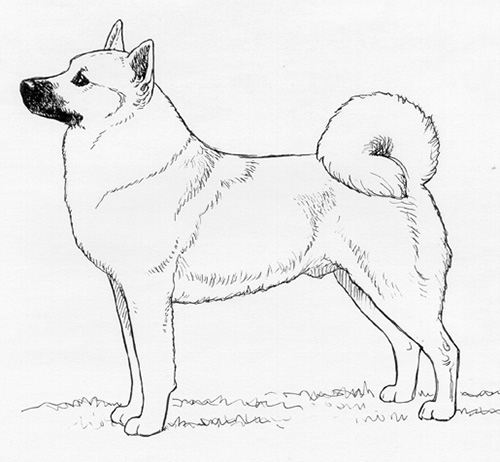Norwegian Buhund
Northern Breed Group
The goals and purposes of this breed standard include: to furnish guidelines for breeders who wish to maintain the quality of their breed and to improve it; to advance this breed to a state of similarity throughout the world; and to act as a guide for judges.
Breeders and judges have the responsibility to avoid any conditions or exaggerations that are detrimental to the health, welfare, essence and soundness of this breed, and must take the responsibility to see that these are not perpetuated.
Any departure from the following should be considered a fault, and the seriousness with which the fault should be regarded should be in exact proportion to its degree and its effect upon the health and welfare of the dog and on the dog’s ability to perform its traditional work.
History
The Norwegian Buhund is descended from the Spitz-like dogs that traveled with the Vikings on their long land and sea journeys. The modern breed was developed in western Norway, where they herded sheep and guarded farms, and occasionally were used for hunting bear and wolf. Today the breed works with livestock and guards home and family.
The Norwegian Buhund was recognized by the United Kennel Club January 1, 1996.
General Appearance
The Norwegian Buhund is a typical Spitz type herding dog of slightly less than medium size. It has a wedge shaped head, prick ears, a tightly curled tail, and a body that is square in appearance.
Characteristics
Courageous, energetic and friendly, the Norwegian Buhund is quick to learn and eager to please.
Head
The head is wedge shaped, clean, and not too heavy. The differences between males and females should be easily identifiable.
SKULL
Nearly flat. The toplines of the skull and muzzle lie in parallel planes. The stop is well defined, but not abrupt.
MUZZLE
About the same length as the skull, with a straight nasal bridge. The face is well filled under the eyes. The lips are tight and black.
TEETH
The Norwegian Buhund has a complete set of evenly spaced, white teeth meeting in a scissors bite.
Disqualifications: Overshot or undershot bite.
Fault: Even bite.
NOSE
Black.
Faults: Liver colored or Dudley nose.
EYES
The eyes are oval in shape, as dark in color as possible, and have black eye rims. Expression is alert and frank.
Faults: Light eyes. Bulging eyes.
EARS
Medium size, pointed in shape and carried strongly erect.
Disqualification: Ears that are not erect.
Neck
Medium long, clean, strong and well arched.
Forequarters
The shoulders are moderately sloping.
FORELEGS
Straight, with well set elbows and strong but not coarse bone. The pasterns are moderately sloping.
Body
Square when measured from top of the withers to the ground and prosternum to buttocks. The chest is deep, and the ribs are well sprung. The back and loin are short, strong and straight, and the croup is nearly flat.
Hindquarters
The hindquarters are moderately angulated.
HIND LEGS
The thighs are powerful and well muscled. There is moderate angulation at the stifle and the hock.
Feet
Compact and oval.
Tail
Set high, firmly curled and carried over the center of the back, not too much to the side.
Faults: Poorly curled tail. Hanging tail.
Coat
Double, with a thick, rich, hard outer coat that is rather close lying. The undercoat is soft and dense. On the head and the front of the legs, the coat is comparatively short, and longer on the neck, chest, back of thighs and tail.
Faults: Coat that is too long or wavy.
Color
Any shade of wheaten, from pale cream to bright orange, with or without black tipped hairs. A black mask is acceptable. As little white as possible is preferred. Also solid black, with as little bronzing as possible and small amounts of white markings, the fewer the better.
Disqualification: Any color other than those described in the standard.
Height and Weight
Ideal height for males is 17 to 18.5 inches. For females, it is 16 to 17.5 inches. Weight for males is 31 to 40 pounds for males; 26 to 35 pounds for females.
Gait
Free and effortless, with good drive and a firm topline.
Eliminating Faults
(An Eliminating Fault is a Fault serious enough that it eliminates the dog from obtaining any awards in a conformation event.)
More than one half inch under the prescribed heights. More than one inch over the prescribed heights.
Disqualifications
(A dog with a Disqualification must not be considered for placement in a conformation event, and must be reported to UKC.)
Unilateral or bilateral cryptorchid.
Viciousness or extreme shyness.
Albinism.
Overshot or undershot bite.
Ears that are not erect.
Any color other than those described in the standard.

Looking for a Dog?
Find a dog that will fit your family.
Note: The breeders on this list are not endorsed by UKC.
Revised July 1, 2009
©Copyright 1996, United Kennel Club
